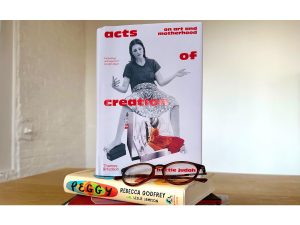The conceptual and material action of splitting determines the two-part continuation of “Flipside.” Meaning is positioned as interdependent, disruptions and reiterations trouble the coherence of a visual field, and the ideological relations that constitute an art object are centered, leaving the stuff of language, excess, and embodiment to the crevices that condition the works on display.
The exhibition is split across two sites.
Let’s start here.
Untitled (Portrait for Counting to Three) is a photogravure etching. It’s editioned as three—or more precisely, an edition of two, and an artist proof. The asymmetry between the artist proof and the two editions accounts for the print’s circulation as a circulation of desire. It’s kind of like . . .
A three way sex joke . . .
Because sex is often too much or too little, but missing the mark is usually the condition of desire.
Where else are things not whole?
Split Red is a diptych painting split across two surfaces, both of which are painted cadmium red. One is canvas and the other is foam core, which is stapled to the wall and anchored to its site.
So a co-dependency . . .
Between the signifying relations that render possible the reading of the work, and the object as such—or rather, a split between the two. What I mean is that the painting, as a monochrome, can’t be reduced to its formal elements, or even to the visual field. It makes a show out of the ideological underpinnings that constitute it as an art object, troubling its mobility because of its unavoidable destruction as a site specific object. The division of the surface in two makes for a broken monochrome, or a failed and incomplete chroma that cannot be unified—one that is less than one.
Where else is color?
In Night Ride #1-10. I first editioned a set of ten mezzotint prints and then re-editioned it by applying a layer of color that overwrote the previous edition’s numbering, reprinting each image as a monotype. The new set is divided by the specificity of color, which displaces each image in relation to the edition.
But then there’s also this palimpsest of mark-making . . .
The layering of signatures and marks traces out the dependance of the printed image to the print-making conventions that authorize it, name it, and condition its value.
So variably a subversion of different techniques.
That idea was central to the first part of Flipside, and here also dictates Forum #1-14. It’s a set of inkjet prints of a Vija Clemins work, one of the night skies. Each print jammed the printer. This marked the separation between the reproducible image and the materiality of the machine, producing a form that is excessive in relation to the original image, or maybe not enough.
Both too much and too little.
Breathing does a similar thing. When I looped the audio of breathing and separated it into two channels, I separated the perfected, smoothed out breaths from their irregularities, splitting the idealized form from its incontinent, embodied support.
Another language making itself heard through inconsistencies and errors . . .
In Untitled, where I screen-print the same gesture, abstract expression becomes concrete replicable expression by virtue of the printmaking process. In other words, freeform expression is raised to the level of the signifier, and this subjects the painting to a sort of devitalization. It’s the same vitality that I try to recuperate in Breathing by outlining the bodily inconsistencies that are sort of the excessive remainder of inhaling and exhaling.
A remainder which nonetheless takes on meaning.
Pushing that further, in Gate Nina, I took a recording of a reading and removed all its words, leaving only the pauses in between. The piece centers these embodied and non-signifying elements which sometimes seem secondary to the transmission of meaning, but on their own, the residual sounds actually delineate an impossibility that prevents language from ever reaching into its non-signifying underside. And in the visual field too, the splattered paint in Untitled, far from being formless, also takes on meaning as non-sense, manifesting the absence of signification without exiting the domain of meaning.
And Philadelphia, New York City, Boston, Portland . . .
States (Lightfast) is a set of inkjet transfers where I selected towns which traced the pathways of passing eclipses. I thought of it as a celestial event that reaches into a linguistic domain and constitutes a set of signifiers that trace the states from one border to the other. This problematic relationship between the natural and the linguistic is another necessary interdependence, or said otherwise, an impossible split.
at Hot Wheels Athens London
until August 17, 2024




